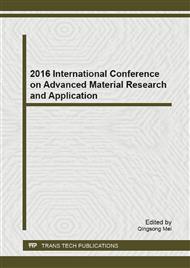[1]
Paul D. Mudgett, John R. Schultz. Fluid Containers for Life Support Systems and Payloads, SAE International. (2003).
Google Scholar
[2]
Mudgett, P.D. et al. Quality of Water Supplied by Shuttle to ISS, SAE Paper 2002-01-2532. 32nd International Conference on Environmental Systems, San Antonio, TX, July (2002).
DOI: 10.4271/2002-01-2532
Google Scholar
[3]
Mudgett, P.D. et al. Quality of Water Supplied by Shuttle to ISS, SAE Paper 2002-01-2532. 32nd International Conference on Environmental Systems, San Antonio, TX, July (2002).
DOI: 10.4271/2002-01-2532
Google Scholar
[4]
John E. Straub II, Debrah K. Plumlee, and John R. Schultz, Sampling and Chemical Analysis of Potable Water for ISS Expeditions 12 and 13, SAE Paper 2007-01-3214. 37th International Conference on Environmental Systems (ICES), Chicago, Illinois, July 9-12, (2007).
DOI: 10.4271/2007-01-3214
Google Scholar
[5]
Mudgett, P.D. et al. Humidity Condensate Sample System for Shuttle, Mir and ISS, SAE Paper 981764, 28th International Conference on Environmental Systems, Boston, MA, July (1998).
Google Scholar
[6]
NASA-JSC Toxicology Memo Toxicological Assessment of Ingestion of Caprolactam in Water, RRN-2000-02, October 18, (2000).
Google Scholar
[7]
Rutz, J. et al. Identification of an Organic Impurity Leaching from a Prototype ISS Water Container, 31st International Conference on Environmental Systems, Orlando, FL, July (2001).
DOI: 10.4271/2001-01-2125
Google Scholar
[8]
NASA-JSC Test Report Teflon FEP Long-Term Fluids Compatibility 48-Week Chemical Analysis Report, JSC-40196, Rev A, January (2002).
Google Scholar
[9]
Pierre, L.M. et al. Collection and Chemical Analysis of Reclaimed Water and Condensate from the Mir Space Station, SAE Paper 961569, 26th International Conference on Environmental Systems, Monterey, CA, July (1996).
Google Scholar
[10]
Webb, K. and Genna, A. Biotechnology Water Treatment System (BWTS) Project Report, Wyle Laboratories Document WLSD555345, September (2002).
Google Scholar
[11]
Debrah K. Plumlee, Paul D. Mudgett and John R. Schultz, Chemical Sampling and Analysis of ISS Potable Water: Expeditions 1-3. 32nd International Conference on Environmental Systems San Antonio, Texas July 1518(2002).
DOI: 10.4271/2002-01-2537
Google Scholar
[12]
Mudgett, P.D. et al. Humidity Condensate Sample System for Shuttle, Mir and ISS, 28th International Conference on Environmental Systems, SAE 981764, Boston, MA, July (1998).
Google Scholar
[13]
N.M. Samsonov, L.S. Bobe, V.M. Novikov, N.S. Farafonov, S. Ju. Romanov, Ju.E. Sinyak etc. A Regenerative Water Supply System for the ISS Russion Segment. 29th ICES, July 12-15, 1999, Denver, USA, SAE Technical paper series (1999)1999-01-(1951).
DOI: 10.4271/1999-01-1951
Google Scholar
[14]
Laurie J. Peterson, Brienne Shkedi, Laura A. Shaw, John F. Lewis and Richard D. Morton, Recommendations for Water Systems in Future Space Applications. 36th International Conference on Environmental Systems (ICES), Norfolk, Virginia, July (2006).
DOI: 10.4271/2006-01-2095
Google Scholar


